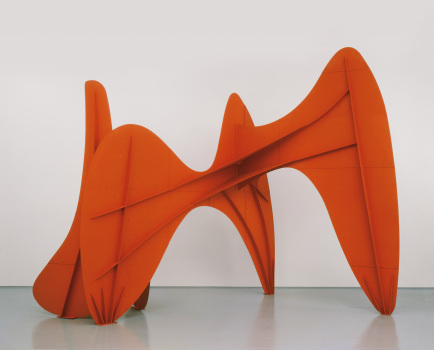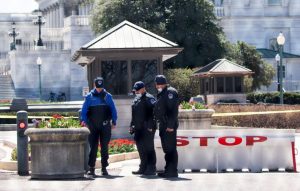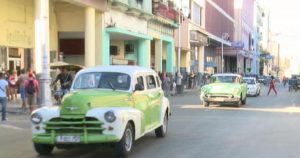Alexander Calder’s “La Grande Vitresse” (1969), on view at the de Young, is a sizable 9-feet-tall, but still only a model to 43-foot-tall version that stands in Grand Rapids, Michigan.
San Francisco’s Golden Gate Park really knows how to welcome visitors who are easing out of the Covid-19 pandemic shutdown.
The Botanical Garden is in springtime bloom, there’s a 150-foot-tall Ferris wheel on the Music Concourse. And the de Young Museum features — direct from Paris! — a fresh and vibrant exhibit pairing Alexander Calder and Pablo Picasso.
“Calder-Picasso,” on view through May 23, was conceived by grandsons of the American (Calder) and Spanish (Picasso) artists, both of which had strong ties to Paris. The hyphen connecting their names in the exhibit’s title suggests they knew each other or might have worked together. They didn’t, and the artistic relationship the museum touts is strained.
Still, the exhibit is a delightful presentation, full of surprises throughout the museum’s big, airy galleries. It offers a chance to follow the careers of not one but two of the 20th century’s most innovative artists.
Nearly 200 works are on display, from the mobiles Calder invented to his massive model for a steel sculpture; from Picasso’s lithographs to the famous “Bull’s Head” he created from a discarded bicycle seat and handlebars.
Picasso seems to be around every corner in modern art shows, but this exhibit gives Calder a closer look. Calder’s wire sculptures of dancers and circus performers — made nearly a century ago in Paris — still seem fresh. And it may be a surprise for some viewers to discover that his mobiles of wire and metal panels — so identified with Midcentury Modern American style — were first created in 1931.
Calder’s mobiles — more than a dozen are on display — now seem familiar as well as quirky. They fit comfortably into his notion that “the underlying sense of form in my work has been the system of the universe, or parts thereof.”
The exhibit, which first opened at the Picasso Museum in Paris in 2019, has a scholarly bent as well. The French curators explained that both Calder and Picasso “wanted to present or represent non-space.” Calder did it with a “subtraction of mass,” Picasso “by expressing contortions of time.”
In San Francisco, the de Young points to a “compelling visual conversation” between them. Certainly Picasso’s works are most interesting in relationship to Calder’s pieces. “The Bull, 11th State” (1946), strips Picasso’s series of lithographs down to the simplest and most expressive lines — as did Calder in his wire sculptures.
Both artists worked in sheet metal and bronze late in their careers, and Picasso’s tall, blackened bronzes on display, from his series “The Bathers” (1950s), look as if they might walk across the gallery to inspect “La Grande Vitresse” (1969), Calder’s bright red, 9-foot-tall steel sculpture. It is a model for the version 43 feet tall that stands in Grand Rapids, Michigan.
At the other end of the size spectrum is Calder’s 15-inch-long wire fish sculpture (1929) that is hung as a surprise “catch” for visitors above the entry to one gallery.
If “Calder” is synonymous with “mobile” for many art lovers, this exhibit extends his legacy. Born in 1898 in Pennsylvania, he was the son and grandson of notable sculptors. His mother, Nanette Lederer Calder, was a painter.
Calder earned a mechanical engineering degree at 21, decided to be an artist at 23 and sailed for Paris at 28. He made quite an impression: His friends and mentors included Joan Miro, Marcel Duchamp and Jean Arp. (Now, those three would be great partners in another exhibit!)
As an art student, Calder was known for conveying movement in his drawings with a single unbroken line. Next step: wire. The de Young exhibit features a trove of these “pre-mobiles.” Calder’s “Ball Player” (circa 1927) and “Acrobat” (circa 1929) are both bold and dynamic — although they’re only wire.
One treasure from this period is Calder’s “Aztec Josephine Baker” (1930), one of his five sculptures of the African-American dancer and singer who took Paris by storm in the 1920s. Calder’s technique is simple but thoughtful: he provides the wire “sketch,” the viewer fills in the details.
The exhibit leaves plenty of room for widespread Calder mobiles such as “Ahab” (1953). It isn’t really meant to portray the whaling ship captain from “Moby-Dick,” the museum label says, but to convey “plunging and cascading forms.” Indeed it does, with a spotlight that gives resonance to its shadow as well.
‘CALDER-PICASSO’
When: Through May 23. 9:30 a.m.-5:15 p.m. Tuesday-Sunday
Where: de Young Museum, 50 Hagiwara Tea Garden Drive, Golden Gate Park, San Francisco
Admission: $20-$35, advance timed tickets required as well as masks and social distancing in galleries; 415-750-3600, deyoung.famsf.org



















